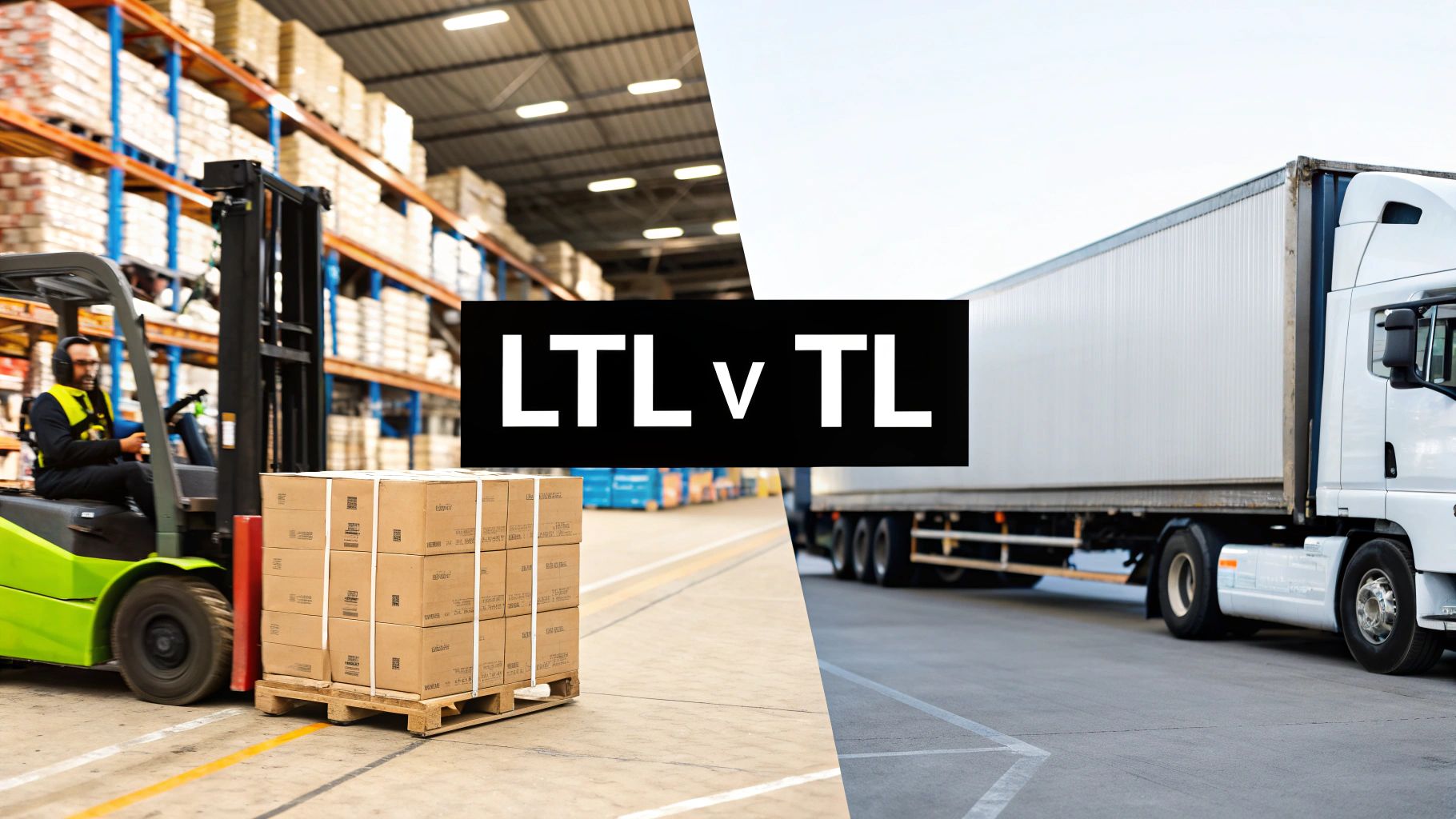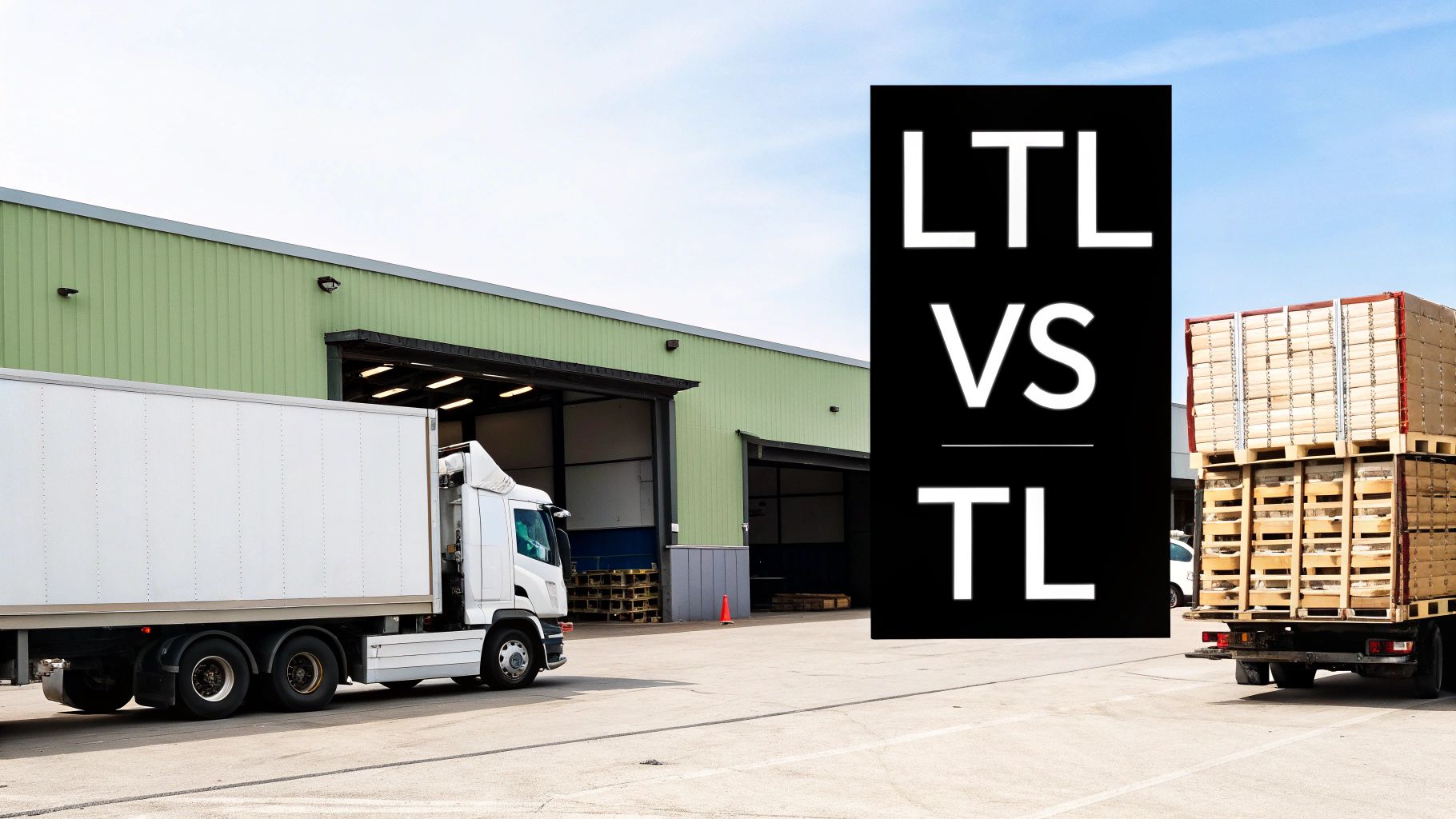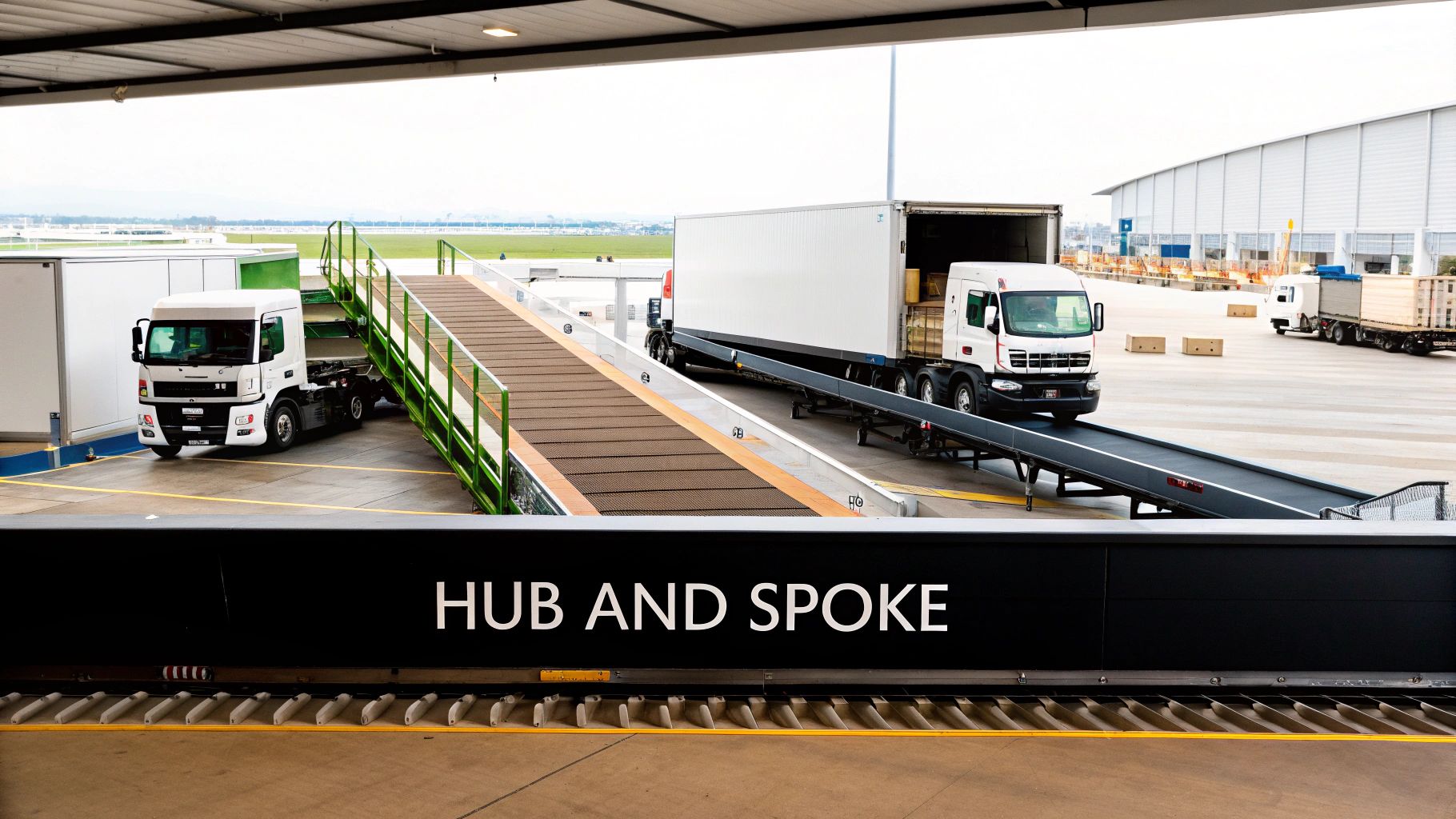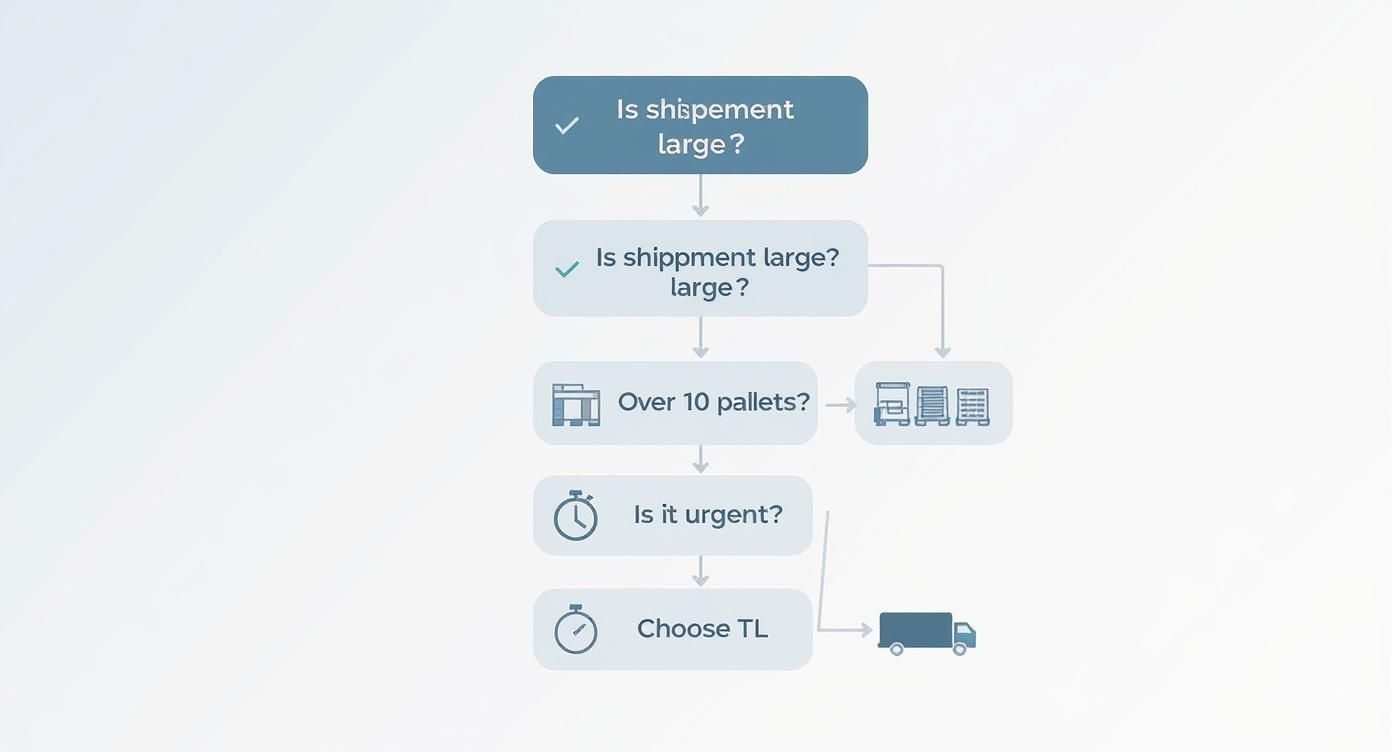Deciding between LTL vs TL? Our guide compares costs, speed, and safety with real-world scenarios to help you choose the right freight shipping method.

The whole LTL vs. TL debate boils down to a single, simple question: Do you need the entire truck?
If the answer is no, you’re likely looking at LTL (Less-Than-Truckload). This is your go-to for smaller shipments that won’t fill a whole trailer, allowing you to share the space and split the cost with other shippers. If you need the whole truck to yourself, you’re in TL (Truckload) territory, also known as Full Truckload (FTL). This is for those big hauls that demand a dedicated, exclusive truck.

Making the right call here is a big deal. It directly hits your budget, your delivery schedule, and even how safely your cargo travels. While both LTL and TL get your freight from A to B on the road, they are fundamentally different beasts. Getting a handle on these differences is the first real step to building a smarter logistics plan.
Think of LTL as a carpool for your freight. Your pallets are riding along with shipments from a bunch of other companies, all heading in the same general direction. This shared model is a lifesaver for smaller businesses or anyone with frequent, smaller-volume shipping needs because you only pay for the slice of the truck you actually use.
On the flip side, TL shipping gives you exclusive rights to an entire trailer. It doesn't matter if you fill it to the brim or only use half the space—it's all yours for the trip. This makes TL the default choice for large-volume, time-sensitive, or high-value shipments that need a direct, non-stop journey from pickup to delivery.
To see the LTL vs TL differences side-by-side, this table breaks down the most important characteristics of each shipping method. It's a high-level overview to help you quickly grasp the basics.
The decision often comes down to a trade-off: LTL offers cost savings at the expense of speed and handling, while TL provides speed and security for a higher overall price, especially for smaller loads.
So, which one is right for you? It really comes down to what matters most for a particular shipment. If your freight is durable and you’ve got some wiggle room on the delivery date, the cost savings from LTL are tough to beat. But if speed is critical and you want to minimize the risk of damage, the dedicated, direct service of TL is easily the better choice.
If you want to dig deeper into the specifics of booking an entire truck, you can learn more about full truckload shipping in our detailed guide.

Ever wondered how a few pallets from your business end up on the same truck as shipments from a dozen other companies? That's the magic of Less-Than-Truckload (LTL) shipping, a system built around a clever logistics model known as hub and spoke. This approach is what makes LTL a game-changer for anyone who doesn't have enough freight to fill an entire truck.
Unlike a direct A-to-B journey, LTL freight takes a more scenic route. A local truck first picks up your shipment and brings it to a nearby terminal. There, your pallets are unloaded, sorted, and grouped with other shipments headed in the same general direction. This consolidation is the secret sauce behind the cost savings.
From there, the combined freight is loaded onto a long-haul truck and sent to another terminal closer to the final stop—sometimes making several hops between hubs. At the destination terminal, your shipment is sorted one last time and loaded onto a smaller, local truck for the final delivery.
Let’s put this into a real-world context. Imagine a growing e-commerce brand that needs to send five pallets of product to a new retail partner across the country. Booking a full truckload (TL) for just five pallets would be a huge waste of money and space.
By choosing LTL, their shipment’s journey looks something like this:
By sharing truck space, the e-commerce brand pays only for the portion their five pallets occupy. This transforms a potentially costly logistics hurdle into a manageable operational expense, enabling growth without massive overhead.
This system is exactly why LTL is so popular with small and medium-sized businesses. It opens up a nationwide freight network without the cost or commitment of a dedicated truck. If you want to dive deeper into the nuts and bolts, check out our guide on what is an LTL carrier.
The LTL market plays by a different set of rules than the highly fragmented TL sector. It’s far more concentrated, with just a handful of major carriers dominating the landscape.
In fact, the top 25 LTL carriers in the U.S. pull in a staggering 91% of the entire market's revenue. This means a few key players—like FedEx Freight, with its nearly 10% market share—have a huge say in pricing and service standards. To put that in perspective, the largest TL carrier barely controls 1% of its market. The difference is stark.
This concentration can lead to more standardized pricing and service, but it also means capacity can get tight, fast. Keeping this dynamic in mind is crucial when you're weighing your LTL vs. TL options.
When you’ve got a big shipment, a tight deadline, or cargo that’s too valuable to risk getting bounced around, Full Truckload (TL) is usually the way to go. Forget sharing space. With TL, you’re booking the entire truck for your freight, and it’s a direct shot from your dock to the destination—no stops, no transfers.
That direct route is the biggest advantage of truckload shipping. It completely bypasses the hub-and-spoke system that LTL relies on, which means your transit times are much, much faster. There's no waiting around at a terminal for other freight to be sorted. Once your goods are on the truck, it’s go-time.
This non-stop journey is also a massive win for freight safety. Your cargo gets loaded once at the start and the truck is often sealed until it reaches its final stop. By keeping handling to an absolute minimum, you slash the risk of damage. It’s why TL is the go-to for anything fragile, high-value, or sensitive.
Ready to see how a dedicated truck can streamline your logistics?
There isn't a hard-and-fast rule, but generally, you start thinking about TL when your shipment tops 15,000 pounds or takes up more than 10 pallet spaces. At that point, booking a whole truck often becomes more cost-effective than paying for a large chunk of an LTL trailer. You're not just buying space anymore; you're paying for exclusivity, speed, and peace of mind.
Picture this: a manufacturer has to get a crucial order of components to an assembly plant. If that shipment is late, the whole production line grinds to a halt, costing thousands of dollars every hour. In a situation like that, the reliability of TL shipping isn't just a nice-to-have—it's essential.
With truckload, the truck shows up at a scheduled time, gets loaded with only their components, and drives straight to the plant. This cuts out variables like terminal congestion or delays from other shippers' freight, keeping that assembly line humming.
By choosing TL for this critical shipment, the manufacturer prioritizes speed and security over the potential cost savings of LTL. The value of uninterrupted production far outweighs the difference in freight cost, making TL the clear strategic choice.
One of the biggest differences between LTL and TL is the market itself. The LTL world is dominated by a handful of massive carriers. The TL market? It’s the exact opposite—a Wild West of tens of thousands of carriers, many of them small owner-operators running just a few trucks.
This fierce competition makes for a very dynamic, and often volatile, pricing environment. For a shipper, this is both a huge opportunity and a headache.
This is where knowing the market really matters. The fragmented nature of the TL world means rates can swing wildly based on supply, demand, fuel costs, and even the time of year. A savvy shipper can play this to their advantage, but it takes experience and access to a broad carrier network to do it right.
Don’t have time to navigate thousands of TL carriers? Let us find the perfect match for your full truckload shipment.
Deciding between LTL and TL shipping really comes down to three things that hit your bottom line and keep your customers happy: cost, speed, and safety. The basics might seem straightforward, but the real-world trade-offs are where things get tricky. Making the right call means understanding how these three elements play off each other for your specific shipment.
Let's dive into a head-to-head comparison of LTL vs. TL to see which one really delivers the goods for you.
For most businesses, the conversation starts and ends with price. The big difference here is what you’re paying for. With LTL, you're just paying for your slice of the truck. With TL, you're renting the whole thing.
Operationally, the average shipment size is a dead giveaway. LTL shipments usually fall between 60 and 15,000 pounds (that’s about 1 to 6 pallets). You’re billed based on the linear feet your freight occupies, not the whole trailer. This is great for sharing space, but that consolidation means longer delivery times and more handling.
Here’s how the cost dynamics typically shake out:
The tipping point is often when a large LTL shipment, bogged down with all its accessorial fees, starts costing as much as a dedicated truck. My advice? Always get quotes for both options if you’re shipping more than six pallets.
Getting a handle on these pricing models is the key to stretching your shipping budget. If you want to really dig into the nitty-gritty, check out our guide on how to calculate freight rates.
How fast do you need it there? This question is a huge factor in the LTL vs. TL debate. Think of a full truckload as a direct flight, while LTL is more like a regional bus that makes a bunch of stops along the way.
Full Truckload (TL) Speed:
A TL shipment is a straight shot. The carrier picks up your freight and drives it directly to the destination—no detours. This makes it incredibly predictable and perfect for anything time-sensitive. A cross-country haul from Los Angeles to New York can often be done in just 4-5 days.
Less-Than-Truckload (LTL) Speed:
LTL is naturally slower because of its hub-and-spoke system. That same Los Angeles to New York trip could take 7-10 days or even longer, as the truck stops at different terminals for sorting, unloading, and reloading.
This decision tree gives you a quick visual for weighing speed and size.

As you can see, when a shipment is both large and needs to get there fast, the direct, speedy route of TL shipping is the obvious winner.
The last piece of the puzzle is the safety of your cargo. How much handling can your products take? The journey your freight takes has a huge impact on the risk of damage.
With a TL shipment, your freight is loaded once and unloaded once. Period. The trailer is often sealed, meaning no one touches your goods until they arrive. This minimal handling makes TL the hands-down best choice for:
On the other hand, an LTL shipment gets handled a lot. It's loaded and unloaded at the first terminal, maybe at a transfer hub or two, and then again at the destination terminal. Every time it's moved, there’s a new risk of damage, loss, or misplacement. LTL carriers are pros, but the risk is just fundamentally higher than the sealed, direct journey of a full truckload.
Knowing the technical difference between LTL and TL is one thing, but knowing exactly when to pull the trigger on an LTL shipment is what separates the pros from the novices. LTL isn't just a budget option for small freight; it's a strategic move that can help you manage inventory, expand your reach, and keep a tight rein on costs.
Let's step away from the definitions and look at some real-world situations where LTL is the hands-down winner. These are the moments where its shared-space model becomes a genuine competitive advantage.
Picture an e-commerce store that's finally taking off. The problem? Their hot-selling items—think small furniture or oversized electronics—are too big and heavy for standard parcel services. But booking an entire truck for just one or two bulky items per order would sink their profit margins instantly.
This is the exact gap LTL was made to fill. The business can ship a few pallets of these larger products at a time, only paying for the portion of the truck their freight occupies. It's the perfect solution for e-commerce brands needing to affordably ship bulky goods without having to sit on a mountain of inventory.
Imagine you're a supplier for a chain of retail stores scattered across a few states. Sending a full truck to each location would be a logistical nightmare and a massive financial drain.
LTL offers a much smarter way forward. You can consolidate shipments for several different stores onto a single LTL truck. This setup allows for smaller, more frequent deliveries to each storefront, helping them keep shelves stocked without getting buried in backstock. It’s a classic play for building a more agile and responsive supply chain.
The rise of e-commerce and just-in-time inventory has made LTL more crucial than ever. It gives businesses the flexibility to meet modern consumer demands without paying for a dedicated truck.
The market data backs this up. The global LTL market was valued at $216.68 billion in 2023 and is on track to hit $342.09 billion by 2030, with a 6.9% compound annual growth rate. This surge is powered by the "light LTL" segment—freight that's too big for parcel but not enough for a full truck—which now drives over 66% of global LTL revenue. You can dig deeper into these LTL market trends on Grand View Research.
What about those smaller, one-off shipments? Maybe you need to get a few product samples to a high-value prospect, or you need to ship the available items from a partial order to a key customer right away. Booking a full truck is obviously overkill.
LTL provides the perfect middle ground. You get a professional freight service that handles palletized goods with care, which looks a lot better than sending a dozen separate parcel boxes. It's the ideal choice for:
In all of these cases, LTL comes out on top because it’s both cost-effective and scalable. It gives you a way to move freight professionally without locking yourself into the volume and cost of a full truckload. If your shipments look like this, LTL is almost certainly the right call.
Don't guess if LTL is the right fit. Get a clear, instant comparison.
While LTL offers amazing flexibility for smaller loads, there are moments when booking an entire truck isn't just a preference—it's a critical business decision. Full Truckload (TL) shipping really shines when speed, security, and dedicated space are absolute must-haves.
Learning to spot these situations is the key to a smarter logistics strategy and, frankly, to protecting your bottom line. Let's walk through the real-world scenarios where going with a full truckload is the only move that makes sense.
For shipments where time is money, TL is the undisputed champ.
Picture a factory floor on the verge of shutting down because a crucial part is running low. A delay of just a few hours could bring the entire production line to a grinding halt, racking up thousands of dollars in losses every single minute. In a case like that, the multi-stop nature of an LTL shipment is a gamble you just can't afford to take.
The same goes for perishables, like fresh produce or temperature-sensitive medicines with a strict expiration date. A direct, non-stop TL route is the only way to guarantee the fastest transit time, protecting the product's value. The extra cost of TL is nothing compared to the potential loss of an entire spoiled shipment.
When the cost of a delay is greater than the cost of the freight, Full Truckload is the only logical option. It cuts out the variables of terminal transfers and shared truck space, giving you a delivery schedule you can actually count on.
Need to lock in a delivery window for a critical shipment? See just how fast a dedicated truck can make it happen.
Security is a huge part of the LTL vs. TL conversation. If you're shipping something valuable, fragile, or both, minimizing how much it gets handled is your number one priority. An LTL shipment might get loaded and unloaded several times as it moves between terminals, and every touchpoint is another chance for damage, loss, or theft.
With a full truckload, your freight gets loaded once, the trailer is sealed, and it isn't opened again until it reaches the destination. This "one-touch" journey is perfect for things like:
Having the whole truck to yourself means your cargo isn’t being shifted around to make room for other pallets. It's a much safer, smoother ride.
Sometimes, the choice just comes down to simple math. LTL is built for smaller shipments, but there's a tipping point where booking one full truck becomes cheaper and easier than managing several large LTL shipments.
This financial crossover point is typically around 10 to 12 pallets or when your freight's total weight climbs past 15,000 pounds. Once you hit that volume, the combined costs of multiple LTL shipments—along with all the potential accessorial fees—can quickly add up to more than the simple per-mile rate of a TL carrier.
If your shipment is getting close to that threshold, always get a quote for both. You might be surprised to find that the dedicated service of a full truckload is actually the more budget-friendly option.
Even with a solid understanding of the basics, real-world shipping often throws a few curveballs. Let's dig into some of the questions that pop up most often when you're deciding between LTL and TL.
Freight class is a big deal in the LTL world, but it's completely irrelevant for TL. Think of it as a standardized pricing system that LTL carriers use to make sense of hauling everything from dense engine blocks to fluffy pillows on the same truck.
It classifies your goods based on four key factors: density, stowability, handling, and liability. For TL, none of that matters. You're buying the whole truck, so the price is usually a simple rate per mile, not a complex calculation based on what's inside.
Absolutely. Tracking is standard practice for both, but how you follow your freight's journey is a bit different.
This is a classic shipping dilemma. You've got freight that's a little too big or heavy for standard LTL, but not nearly enough to fill a whole truck. You’re in what I call the "gray area," and it's actually a great place to be.
This is where options like "volume LTL" or partial truckload really shine. These services were created specifically for shipments that need a good chunk of space—say, 6-12 pallets—but don’t require the entire trailer.
My best advice is to quote it both ways. When your shipment is in that gray area, getting an LTL, volume LTL, and a TL quote is the only way to find the true sweet spot for cost and service.
Taking a few extra minutes to compare these quotes can save you a surprising amount of money. It ensures you aren't paying for empty space you simply don't need.
Unsure which option is best for your specific shipment? Let us run the numbers for you.